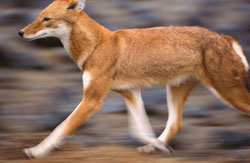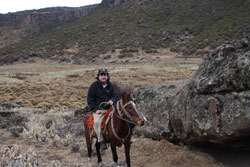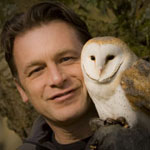2011 - Ethiopian Wolf Expedition
An exclusive trail riding expedition in the remote Bale Central Peaks observing Ethiopian wolves with their pups
 Ethiopian wolves are the rarest African carnivore, and the only wolf in Africa. Fewer than 400 wolves remain in a handful of mountain enclaves, and more than half are found in the Bale Mountains. The Bale Mountains are the ‘Roof of Africa’ – with a 1,000km2 of Afroalpine meadows and Erica moorlands this is indeed the largest mountain plateau in the continent. The wolves are the guardians of these magic lands, visited only by a handful of hard-core lupine enthusiasts and African travellers every year.
Ethiopian wolves are the rarest African carnivore, and the only wolf in Africa. Fewer than 400 wolves remain in a handful of mountain enclaves, and more than half are found in the Bale Mountains. The Bale Mountains are the ‘Roof of Africa’ – with a 1,000km2 of Afroalpine meadows and Erica moorlands this is indeed the largest mountain plateau in the continent. The wolves are the guardians of these magic lands, visited only by a handful of hard-core lupine enthusiasts and African travellers every year.
Check out the personal diary of our successful Living with Wolves trip that took place last February.
 The Ethiopian Wolf Conservation Programme protects Ethiopian wolves and their Afroalpine habitats and was founded and is run by Prof. Claudio Sillero. It’s the only genuine trip and is hosted by leading wolf expert Prof. Claudio Sillero. This is unique opportunity to live with wolves and unlike other rare carnivores the wolves are easily found and observed. We will be able to see wolf packs from close up, and observe their foraging and social behaviour at a time when many packs will be looking after their pups.
The Ethiopian Wolf Conservation Programme protects Ethiopian wolves and their Afroalpine habitats and was founded and is run by Prof. Claudio Sillero. It’s the only genuine trip and is hosted by leading wolf expert Prof. Claudio Sillero. This is unique opportunity to live with wolves and unlike other rare carnivores the wolves are easily found and observed. We will be able to see wolf packs from close up, and observe their foraging and social behaviour at a time when many packs will be looking after their pups.
 On this 11-day expedition to the hinterland of Bale, Prof. Claudio Sillero will share with you many of the secrets of these remote, wild mountains. You will travel on horse-back (no previous experience required) and on foot, through mountain valleys amid giant lobelias and get close and personal with the wolves. You will camp beside weird lava formations, watch raptors, and meet the Oromo pastoralists that make Bale their home. Whilst the camping will be to the highest standard available and as comfortable as practicably possible, this expedition requires a reasonable level of fitness and a spirit of adventure. You will be trekking on foot and horseback in remote mountainous areas up to 4,200m. Luxury accommodation awaits you pre and post your living with wolves’ experience.
On this 11-day expedition to the hinterland of Bale, Prof. Claudio Sillero will share with you many of the secrets of these remote, wild mountains. You will travel on horse-back (no previous experience required) and on foot, through mountain valleys amid giant lobelias and get close and personal with the wolves. You will camp beside weird lava formations, watch raptors, and meet the Oromo pastoralists that make Bale their home. Whilst the camping will be to the highest standard available and as comfortable as practicably possible, this expedition requires a reasonable level of fitness and a spirit of adventure. You will be trekking on foot and horseback in remote mountainous areas up to 4,200m. Luxury accommodation awaits you pre and post your living with wolves’ experience.
Become one of the few privileged travellers to live with Ethiopian wolves.
Living with Ethiopian Wolves with Prof. Claudio Sillero
Please register your interest now or call 01825 714310
 Prof. Claudio Sillero is the founder and Director of the Ethiopian Wolf Conservation Programme. His resolve and energy is the driving force behind the research and conservation of the Ethiopian wolf. He raises all the finance to sustain the project and actively spreads the awareness of the plight of the Ethiopian wolf. Claudio is also Head of Conservation at the Born Free Foundation and holds the post of Bill Travers Fellow for Wildlife Conservation at the University of Oxford. Claudio is the Chair of the IUCN Canid Specialist Group. He supervises other conservation projects worldwide, including the Satpura Landscape Tiger Programme in central India and the Transfrontier Conservation of Andean Cats project in South America. Claudio is a passionate conservation biologist actively committed to mitigating wildlife-human conflict through hands-on initiatives – the Ethiopian Wolf Conservation Programme is a prime example of this.
Prof. Claudio Sillero is the founder and Director of the Ethiopian Wolf Conservation Programme. His resolve and energy is the driving force behind the research and conservation of the Ethiopian wolf. He raises all the finance to sustain the project and actively spreads the awareness of the plight of the Ethiopian wolf. Claudio is also Head of Conservation at the Born Free Foundation and holds the post of Bill Travers Fellow for Wildlife Conservation at the University of Oxford. Claudio is the Chair of the IUCN Canid Specialist Group. He supervises other conservation projects worldwide, including the Satpura Landscape Tiger Programme in central India and the Transfrontier Conservation of Andean Cats project in South America. Claudio is a passionate conservation biologist actively committed to mitigating wildlife-human conflict through hands-on initiatives – the Ethiopian Wolf Conservation Programme is a prime example of this.
For more info on The Ethiopian Wolf Conservation Programme:
 The Bale Mountains (2,500 – 4,377m)
The Bale Mountains (2,500 – 4,377m)
The scenery is spectacular, wild and varied with lava flows, dramatic granite outcrops, Afroalpine moorlands, Afro-montane forests, escarpments and high alpine plateau. The Bale Mountains are the largest mountain plateau in Africa (“the roof of Africa”) and home to the rarest African carnivore and the only wolf in Africa. Fewer than 400 wolves remain in a handful of mountain enclaves, and more than half are found in the Bale Mountains. The Bale Mountains are a vast wilderness area with no tracks and a pristine but fragile environment. Only a few Oromo families can be found living in isolation up on the plateau. The Bale Mountains are best visited during the dry season from November – February when the days are normally clear and warm and nights can be frosty. On the Sanetti Plateau sleet and snow is possible. Temperature will fall with increasing altitude and at night and could vary between +26C and –15C. At this time of year the Helichrysum, everlasting flowers of the Afroalpine area and the Hagenia and Hypericum trees are in flower, the wolves have their pups and so there will be lots of wolf social behaviour to observe around the dens.
List of Endemic Species in the Bale Mountains
| Mammals species include : | Endemic birds include: |
| Mountain Nyala Starck’s Hare Ethiopian wolf Bale monkey Giant Molerat Lovat’s mouse Nikolaus’ mouse Mahomet’s mouse White-footed rat White-tailed rat Grey-tailed rat Blick’s grass rat Shrews Bats |
Wattled ibis Blue-winged goose Rouget’s Rail Spot-breasted plover White-collared pigeon Yellow-fronted parrot Black-winged lovebirds Banded barbet Golden-backed woodpecker Abyssinian longclaw White-winged cliff-chat Abyssinian catbird White-backed black tit Black-headed forest oriole Thick-billed raven Black-headed siskin |
Camping & horse trekking in the Bale Mountains
 Previous riding experience is not necessary, as the riding is relatively easy (western-style) and will be taken at a slow walking pace with lots of rest stops. You may choose to walk and lead your horse for sections to give your legs a rest. The horses are selected for their calm nature and sure footing. Walking long distances at high altitude is not recommended unless you are extremely fit, so riding is preferable.
Previous riding experience is not necessary, as the riding is relatively easy (western-style) and will be taken at a slow walking pace with lots of rest stops. You may choose to walk and lead your horse for sections to give your legs a rest. The horses are selected for their calm nature and sure footing. Walking long distances at high altitude is not recommended unless you are extremely fit, so riding is preferable.
For maximum comfort and warmth we will provide a fully portered and catered mobile camp with individual expedition-grade tents from the UK for everyone (2-man Terra Nova Quasar), mess tent, bucket showers (cold water) and toilet tents from Ethiopia. You will need a 4-season sleeping bag, therma-rest or equivalent sleeping mat, inflatable pillow, towel, thermal underwear, walking shoes or trainers, Gortex waterproof and windproof jacket and over-trousers, and a down jacket. A full list of recommended gear will be provided prior to travel. All your personal equipment and camping gear is carried for you by packhorses or in the 4WD vehicles
Itinerary
| 12 November | 0705 hours depart London. 2110 hours arrive Addis Ababa (2,400m). After clearing customs and buying your local currency meet Claudio Sillero and your senior Spencer Scott Travel organiser. Transfer to the Hilton Hotel. |
| 13 November | Breakfast in the hotel. In 4WD vehicles drive to the shores of Lake Langano in the rift valley (4 hours). Picnic lunch. Continue driving to Dinsho (3,100m) in the Bale Mountains (approx. 4 hours). Afternoon tea with the EWCP team at their research centre adjacent to the Bale Mountains National Park HQ. Transfer to the private mobile tented camp in the Web Valley, which will have already been set up at Sodota Camp, next to the EWCP refuge hut (3,500m). The Web Valley is home to several wolf packs and Sodota is an excellent base for wolf watching. Settle in to camp before dinner is served. |
| 14 – 15 November | The party will divide in to smaller groups of 3 – 5 people to facilitate close up encounters with the wolves and minimize disturbance. Groups will be led by Claudio and Alo; EWCP senior wolf monitor. You will explore the Web Valley looking for wolves on foot, horseback or from vehicles. Each day commences with an early cup of tea and biscuits before heading straight out to search for wolves as dawn breaks. It’s back to camp for a hearty breakfast before going back out for a longer foray with the parties rendezvousing for a picnic lunch. Continue wolf watching through the afternoon. We should also see rock hyrax, giant molerats, mountain nyalas, warthogs and olive baboons, Menelik’s bushbuck, Bohor reedbuck, blue-winged geese, wattled cranes and many raptors, and may get the chance to spot serval cats, golden jackals and spotted hyaenas. Return to Sodota camp for showers, drinks and dinner. |
| 16 November | Set out at dawn to observe wolves close to the camp. Break camp after breakfast. All the camping and mess equipment will be dismantled and packhorses will take all this as well as your personal gear to the next camp at Keyrensa, in the remote Bale Central Peaks (3,800m). You’ll travel at a fairly leisurely pace predominantly on horseback but with the option to walk some of the time. The distance to be covered is approximately 20km – 6 hours. The Keyrensa Valley divides two lava flows where the views, isolation and wildlife are exceptional. As well as being the habitat of the Ethiopian wolf, this area is great to watch rock hyrax, klipspringer and many resident and migrant raptors including Augur buzzard, lanner falcon, kestrel, tawny, steppe, black and golden eagles. Lammergeier and Abyssinain long-eared owls also live here. The journey will be broken with wolf watching opportunities, rest stops and a picnic lunch. The camp should all be set up on arrival with a welcoming campfire and dinner served shortly afterwards. |
| 17 November | Set out at dawn to observe wolves close to the camp. Break camp after breakfast. All the camping and mess equipment will be dismantled and packhorses will take all this and your gear to the next camp at Wassema (4,100m). You will travel again on horseback and will be able to break the riding with some walking. The distance today is approximately 15km – 4 hours. The journey will be broken to take in the awesome views and to observe wolves, in addition to rest stops and a picnic lunch break. The camp should all be set up on arrival with a welcoming campfire and dinner served shortly afterwards. |
| 18 November | Set out at dawn to observe wolves close to the camp. Break camp after breakfast. All the camping and mess equipment will be dismantled and packhorses will take all this and your gear to the next camp at Sanetti (4,100m), where you will be reunited with the 4WD vehicles, the relative ‘luxury’ of a second EWCP refuge hut and even the prospect of a shower! Youwill travel across the Sanetti Plateau on horseback and on foot covering approximately 20km – 6 hours. The journey will be broken with wolf watching opportunities, rest stops and a picnic lunch. The camp should be set up on arrival with dinner served shortly afterwards. Time permitting a dusk drive close to the camp can offer some rewarding wolf sightings. |
| 19 November | Bid farewell to our riding horses, packhorses and grooms. Wolf watching from Sanetti is done on foot or in vehicles. All meals at camp. |
| 20 November | After a last dawn wolf watching foray and camp breakfast it’s time to leave the Bale Mountains and head back to civilisation. The first hotel with showers and changing facilities is just a couple of hours drive away in Goba. After freshening up and saying goodbye to the EWCP team you will continue on to Lake Langano, breaking the 6 – 7 hour journey with a picnic lunch and rest stops. Dinner and overnight at the rustic Bishangari Eco-Lodge, situated on the remote southeastern shores of Lake Langano. Accommodation is in 10 village-style tukuls (huts) with four shared bathrooms. |
| 21 November | Breakfast and lunch at the lodge. Spend the morning relaxing or bird watching in the lush riverine forest around the lodge. Drive to Addis Ababa ( approx. 4 hours). Dinner in a local restaurant. Transfer directly to the airport. 2323 hours depart Addis Ababa. |
| 22 November | Arrive London Heathrow 0805 hours. |
| Number of participants : | 6 – 9 |
| Price per person : | £5,650.00 |
Price includes:
International flights on Ethiopian Airways
4WD vehicles (3 persons per vehicle)
Individual trekking horses
1 night Hilton Hotel, Addis Ababa
1 night lodge accommodation
7 nights camping in individual expedition-grade tents
All meals
Fully serviced mobile tented camp with mess tent, shared WC’s and bucket showers
Sustainable firewood
Packhorses and grooms
National Park fees
EWCP Director and wolf monitors
Spencer Scott Travel Director
Donation to the Ethiopian Wolf Conservation Programme
All images courtesy of A L Harrington & Prof. Claudio Sillero.












